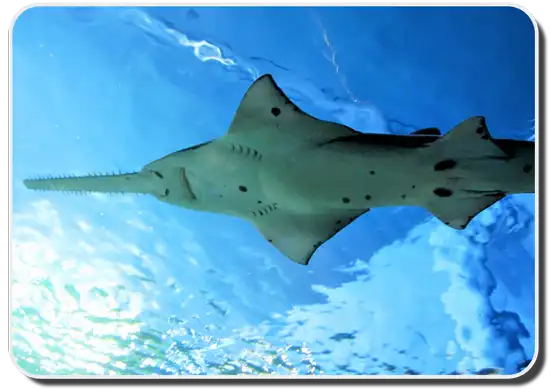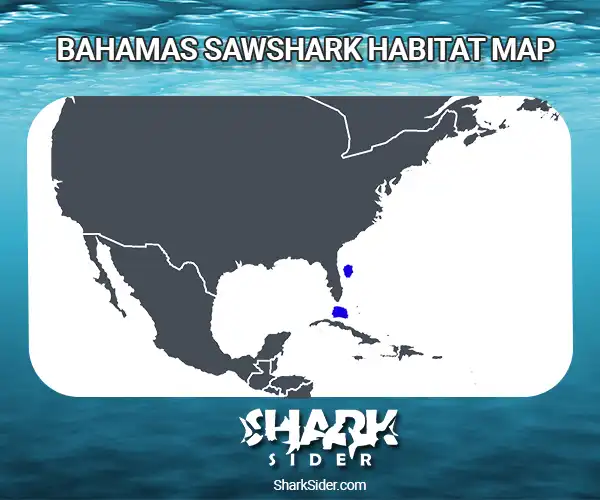The Bahamas Sawshark (Pristiophorus Schroederi) belongs to the family Pristiophoridae. In contrast to its Asian “congener” (that’s scientist-speak for member of the same genus) that we recently featured – the Pacific-dwelling Japanese Sawshark (P. japonicus) – this species lives in the Atlantic Ocean. It is also known as the American Sawshark.

The distinctive snouts of these sharks are long, flat, and tapered. They have the appearance of sporting a thin, cheesy moustache: really, the whisker-looking barbels are fleshy appendages thought to aid in feeding. Sawsharks have numerous serrated teeth on either side of the snout (hence their common name). Adults grow to be at least 80 cm (31″) long.
Bahamas Sawshark Facts
This fish is a poorly known tropical Sawshark that prefers deep water. It is endemic to the Bahamas region, and is known from only a limited number of specimens.
It has 13 or 14 teeth on each side of the snout in front of the barbels, and then another 9 to 10 on each side behind the barbels. That means it might have a total of about 48 teeth, giving the snout (“rostrum”) its unmistakable saw-like appearance.
Bahamas Sawshark Habitat Map

Habitat and Range
The geographic distribution of this species is a narrow range within the Western Central Atlantic, between Cuba, Florida and the Bahamas. This shark prefers to stay on or near the bottom at depths between 400 to 1,000 m (1330 to 3330 ft).
Basically nothing is known about its population(s), which is thought to be isolated by deeper waters that represent unsuitable habitat. The known range is restricted to the continental and insular slopes around the Bahamas: the Sawshark has never been recorded on the adjacent North American continental slope, and so it is presumed absent from that area.
Feeding Behavior
Nothing is known about the diet of this species. Based on the feeding ecology of other Sawsharks, this creature like eats small fish and invertebrates that live on the ocean bottom. Both the tapered snout and the sensitive barbels are adaptations that could help with finding prey items buried in sand and mud on the sea floor.
Breeding
The Bahamas Sawshark is presumed to be ovoviviparous, meaning that the young are sustained inside the mother with an aplacental yolksac. Pups measure 30 cm (11.8″) long at birth.
Nothing else is known about the life history parameters of this species.
Humans and Conservation
This is a harmless shark, from the perspective of humans that is (shrimps and tiny fish might beg to differ!).
No fisheries are known to be presently targeting this species.
The IUCN Red List deems the Bahamas Sawshark to be “Data Deficient” – that is, a proper assessment is not yet possible because so little is known about its basic biology, and the full distribution is poorly defined.
There is a need for population surveys and more information about the activities of any fisheries within the range of this shark. Any future deepwater activities in the area need to be carefully monitored; the narrow range of the species means that it could be particularly vulnerable to disruption of its habitat.
One country that seemed to have taken some conservation action regarding this species is Mexico. In response to urging by the United Nations General Assembly, Mexico is one of only a handful of the top 20 shark-catching nations (along with Taiwan, the US and Japan – as of 2007) to have adopted a “National Action Plan for Shark Conservation”. The Mexican plan was approved in 2004; it assessed Pristiophorus Schroederi as being endangered or threatened and thus worthy of protection. However, to the best of our knowledge this plan has not been implemented. In other words, the policy has not translated into any formal protection of the species in Mexican waters.
Written By: Kara Lefevre
Sources
Barreira A (2007). The Protection of Sharks: A Legal and Policy Analysis. Prepared by Instituto Internacional de Derecho y Medio Ambiente (The International Institute for Law and the Environment).
Heupel MR (2006). Pristiophorus schroederi. In: IUCN 2012. IUCN Red List of Threatened Species. Version 2012.2.
